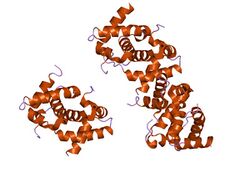Biology:HdeA family
In molecular biology, the HdeA family of proteins (HNS (histone-like nucleoid structuring)-dependent expression A) is a stress response protein family found in highly acid resistant bacteria such as Shigella flexneri and Escherichia coli, but which is lacking in mildly acid tolerant bacteria such as Salmonella.[1] HdeA is one of the most abundant proteins found in the periplasmic space of E. coli, where it is one of a network of proteins that confer an acid resistance phenotype essential for the pathogenesis of enteric bacteria.[2] HdeA is thought to act as a chaperone, functioning to prevent the aggregation of periplasmic proteins denatured under acidic conditions. The HNS protein, a chromatin-associated protein that influences the gene expression of several environmentally-induced target genes, represses the expression of HdeA. HdeB, which is encoded within the same operon, may form heterodimers with HdeA. HdeA is a single domain protein with an overall fold that is similar to the fold of the N-terminal subdomain of the GluRS anticodon-binding domain.
References
- ↑ "HDEA, a periplasmic protein that supports acid resistance in pathogenic enteric bacteria". Journal of Molecular Biology 295 (3): 605–12. January 2000. doi:10.1006/jmbi.1999.3347. PMID 10623550.
- ↑ "Regulatory network of acid resistance genes in Escherichia coli". Molecular Microbiology 48 (3): 699–712. May 2003. doi:10.1046/j.1365-2958.2003.03477.x. PMID 12694615.
 |


